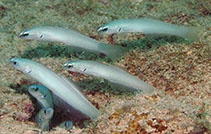| Family: |
Microdesmidae (Wormfishes), subfamily: Ptereleotrinae |
| Max. size: |
13 cm TL (male/unsexed) |
| Environment: |
reef-associated; marine; depth range 1 - 50 m |
| Distribution: |
Indo-Pacific: Red Sea to the Line and Tuamoto islands, north to the Ryukyu Islands, south to the southern Great Barrier Reef. |
| Diagnosis: |
Dorsal spines (total): 7-7; Dorsal soft rays (total): 25-29; Anal spines: 1-1; Anal soft rays: 24-27; Vertebrae: 26-27. Pale to bluish gray in color; pectoral fin base with a narrow, pale blue-edged, black band; postorbital head with irregular, pale to iridescent blue bands and spots. Chin with a median, fleshy protuberance narrowing to a thin fold. Scales embedded, close-set, non imbricate (except on posterior part). 1st dorsal fin lower than 2nd; 2nd dorsal and anal fins elevated anteriorly. Closely resembles P. heteropterus but lacks the blue mark on the tail (Ref. 1602). |
| Biology: |
Inhabits lagoon and seaward reefs, over rubble and sand bottoms (Ref. 9710). Found from shallow silty estuaries and inlets to outer reef lagoons to about 10 meters depth, but may also be seen deep on coastal slopes to 25 meters depth (Ref. 48637). Occur in pairs occupying the same burrow, but at times more than 2 individuals will retreat to the same refuge (particularly true for juveniles). Monogamous (Ref. 52884). Feeds on zooplanktons (Ref. 89972). |
| IUCN Red List Status: |
Least Concern (LC); Date assessed: 11 April 2022 Ref. (130435)
|
| Threat to humans: |
harmless |
Source and more info: www.fishbase.org. For personal, classroom, and other internal use only. Not for publication.
